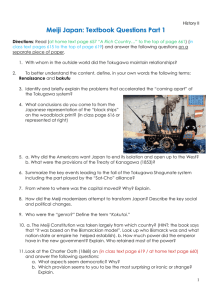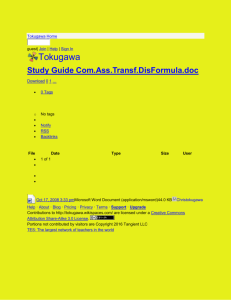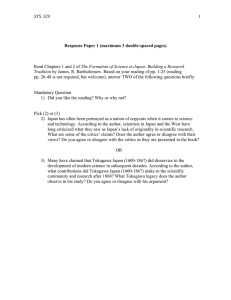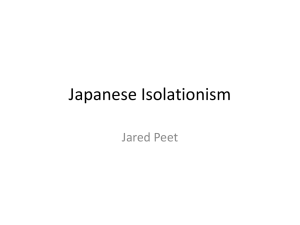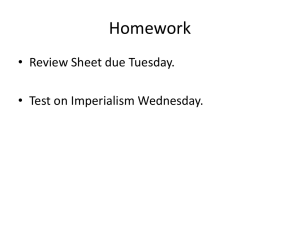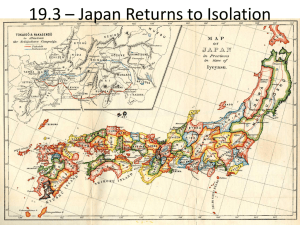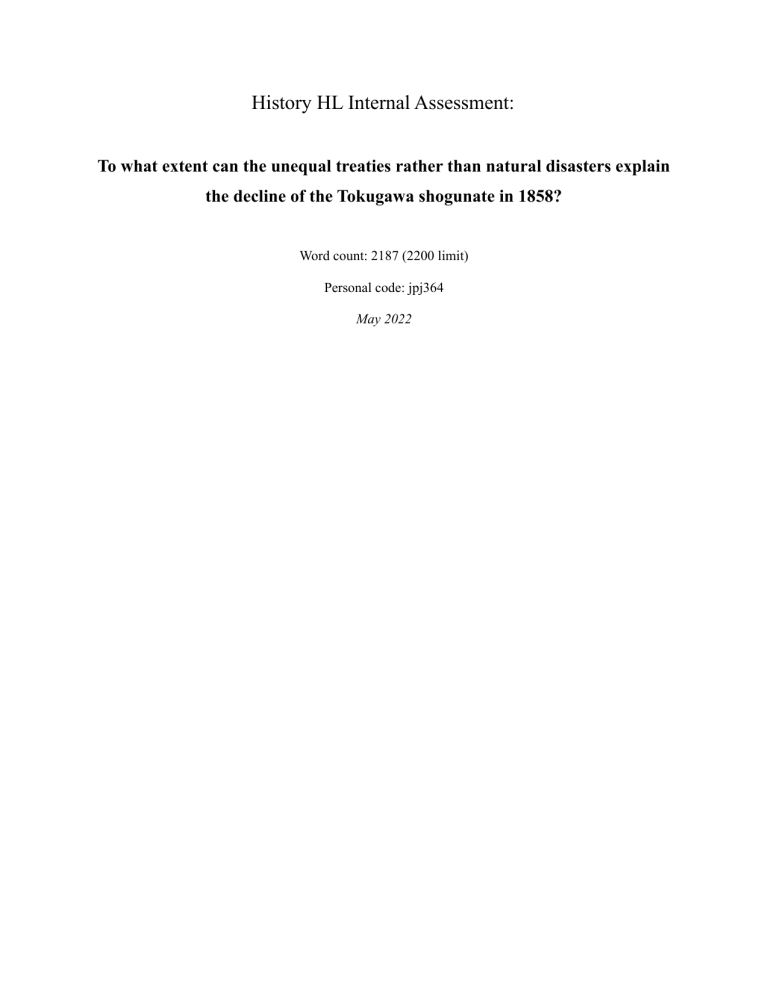
History HL Internal Assessment: To what extent can the unequal treaties rather than natural disasters explain the decline of the Tokugawa shogunate in 1858? Word count: 2187 (2200 limit) Personal code: jpj364 May 2022 SECTION A Identification and evaluation of sources: In this investigation, I will be exploring the question: ‘To what extent were unequal treaties responsible for the decline of the Tokugawa shogunate in 1868?’. I will be looking at two key sources. One of my sources is a primary source which is an online copy of the original ‘Treaty of Amity and Commerce’ between Japan and the United States in 1858 which will provide evidence to show that the unequal treaties were a main factor that contributed to the fall of the Tokugawa shogunate. The other source that I will be using is a secondary source ‘The Making of Modern Japan’ which is a book written by American historian Marius B. Jansen. This book will support my opposing perspective that supports natural disasters as the primary facet that led to the decline of Tokugawa. The first source I will be using is ‘The Treaty of Amity and Commerce’ between Japan and the United States, which is one of the first major unequal treaties signed between Japan and a foreign country. A value of this source is that this treaty was established in 1858, and although this is an online copy of the original document, the content contained is an accurate rendition that can provide insight into Edo Japan and the time in which the Tokugawa shogunate’s policies had control over 19th century Japan. Another value of this source is that despite being an online copy, it is sourced from the ‘Database of Japanese Politics and International Relations’ from the University of Tokyo and can therefore be deemed as a reputable source. The original treaty was created with the purpose of opening up Japan’s ports for US trade and residence, and is useful in examining the motives of the United States and their role as a catalyst for the opening up of Japan. A limitation of this source is that the content is lacking in the description of events that have occured prior to the creation of this treaty, and mainly focuses on the freedoms of the American people within Japan rather than effects it will have on the Japanese citizens or the Bakufu. Therefore it may not provide enough evidence that can highlight the unequal treaty as the main driving force that led to the decline of Tokugawa. The second source I intend to use for my investigation will be the book ‘The Making of Modern Japan’ by Marius B. Jansen, published in 2000. A value of this source is that it was written by a well-renowned professor of History at Princeton University, who has also written numerous other books about the history of Japan ranging from the Sengoku period up to postwar Japan. This suggests that this source is well researched, as the information contained within the book comes from a knowledgeable author. Another value of the source is that it is informative regarding the events that took place before and after Perry’s arrival and the signing of the treaties. The tone of writing mostly remains neutral, and presents a range of different perspectives. A limitation to this source is that the content of this book mostly focuses on political and economic change but omits detail on social and cultural changes which are also important factors that led to the Tokugawa shogunate’s downfall. SECTION B Investigation: The Tokugawa period that lasted from 1603 to 1867 was a relatively peaceful time for the people of Japan. However, despite the initial peace and stability, there were still many underlying problems that gradually led to the eventual downfall of the Tokugawa shogunate. The Tokugawa shogunate's official policy was Sakoku, which prohibited foreigners from entering or leaving the country under penalty of death. However, with the arrival of Commodore Matthew Perry in 1854 and his proposed Convention of Kanagawa, domestic tensions had greatly increased which led to the weak bakufu now finding themselves challenged by Western powers with the intent of opening Japan to trade and foreign intercourse. In addition, Japan was plagued with many natural disasters during the Tokugawa period which resulted in peasant unrest, mass protests, and a general sense of crisis. This caused many to seek for the overthrow of the shogunate. Hence, I will be analysing and providing evidence for two perspectives. My first perspective argues that the unequal treaties such as the Treaty of Amity and Commerce were the main factors that contributed to the fall of the Tokugawa. Contrastingly, the second perspective asserts that natural disasters such as floods and droughts were the main factors that led to the fall of Tokugawa. First and foremost, there is evidence that proves that the unequal treaties, in particular the Convention of Kanagawa (1854) and the Treaty of Amity and Commerce (1858), were the main catalysts which led to foreign interference and eventually the decline of the Tokugawa. The Convention of Kanagawa imposed by Commodore Matthew Perry was signed between the United states and the Tokugawa shogunate on March 31st 1854 under the threat of force. This can be considered significant as it was an act of foreign intervention by the Americans that successfully precipitated the beginning of the opening up of Japan, and hence marked an era for the beginning of change. Specifically, this unequal treaty had effectively ended Japan’s 220 year-old policy of national seclusion and starting from 1858 up to 1864, sakoku became discredited and kaikoku and was adopted as a new Japanese virtue. Due to the success of the kaikoku policy, free trading amongst foreign countries was enabled and allowed Japan’s static gains from trade to increase to 8-9% of its GDP at the time (Bernhofen, 2011). The terms of the Kanagawa treaty include the opening of two ports in Shimoda and Hakodate, secured supplies of coal, and guaranteed assistance to shipwrecked US crews. This treaty set off a domino chain effect for the signing of other similar treaties in an attempt to establish diplomatic relations with other Western powers, such as the Harris Treaty of 1858. By analysing the evidence above, it is clear that the Convention of Kanagawa garnered more opposition against an already dismal political situation and backwards society. The content of the Harris treaty included the opening of five trading ports at Edo, Kobe, Nagasaki, Niigata and Yokohama, extraterritorial rights for Westerners, exchange of domestic and foreign currencies, opening of markets in Tokyo and Osaka, and the lack of Japanese tariff autonomy (Bernhofen, 2011). Therefore, as a result of the Harris treaty, Japan opened up to trade officially on July 4th 1859. Article 9 of the Harris treaty states that if Japan were to grant “any other nation or nations privileges and advantages which are not herein granted to the United States and the citizens thereof, that these same privileges and advantages shall be granted likewise to the United States and citizens thereof, without any consultation or delay''. This meant that through the signing of the treaty, they were effectively allowing the US to claim any benefits granted to other states which put the Japanese into an disadvantageous bargaining position in the decades to come. In turn, this caused many people to view these unequal treaties a sign of weakness. Secondly, there is evidence that proves that the unequal treaties resulted in new political ideologies and social unrest, which cements unequal treaties as one of the main factors that led to the end of the Tokugawa period. The outrage proved to be a catalyst for the Sonno Joi movement, which was a political philosophy that translates to ‘Revere the Emperor, expel the barbarians’. This was used by activists not only to support the throne but also to embarrass the bakufu. The shogun was unable to prohibit foreign visitations, therefore the deeply conservative and nationalistic Japanese, especially within the provinces of Satsuma and Choshu, believed he should be punished and replaced (Watkins). From my secondary source ‘Making of Modern Japan’, Jansen states that “The agreements Perry and Harris had wrung from reluctant bakufu negotiators made it necessary for Japan to abandon policies of seclusion and enter the international order on terms defined by the West. The struggle to regain its sovereignty then forced Japan to embark on policies of centralization and institutional innovation in order to build a modern nation-state, and involve the basic restructuring of domestic society”. This suggests that these unequal treaties forced Japan to step into the global sphere of economics and politics and leave behind their conservative mindsets in order to develop and grow as a nation. Therefore, the bakufu were overthrown by supporters of the imperial court and their political system was significantly reformed from that point forward. According to all the evidence mentioned above, it can be seen that the unequal treaties were undoubtedly a key factor in the transformation of Japan. On the other hand, other pieces of evidence suggest instead that natural disasters were the main factor that contributed to the fall of the Tokugawa shogunate. Japan’s meteorological conditions were largely the main cause for many droughts, floods, and famines that have occurred in Japan during the Tokugawa period. There have been roughly around 20 great famines between 1675 and 1837, but amongst them there are three which have caused the most damage: Kyoho, Tenmei, and Tempo. The most common cause of harvest failure was cold weather and prolonged rainy periods during the summer, which often resulted in crop shortages and famines that led to the deaths of over 100,000 peasants. The Great Tenmei famine that spanned from 1782-88 emerged as a result of poor weather conditions that led to sharp declines in crop yields. The shortage in food stocks were further exacerbated by other natural disasters such as the eruption of Mount Iwaki and Asama in which the volcanic ash emitting from the active volcanoes had lowered the levels of solar radiation, which then brought about unnaturally cold weather and widely damaged crops. Additionally, the natural disasters that occured within the Tokugawa period was essential as it had further proved the weakness of the bakufu. Their traditional remedies that sought to bring about reform in Edo Japan and their refusal to modernize had quickly backfired on them. In turn, the famines led to peasant uprisings against officials and social unrest. One notable figure known as Oshio Heihachrio led the 1837 Osaka rebellion after the Tempo famine. He harboured anti-Tokugawa sentiments and his ideologies had quickly spread amongst the common people after the uprising. His revolt, even if it was suppressed in one day, attracted nation-wide attention because it occurred in Osaka which was described as the directly controlled Bakufu commercial centre. Although natural disasters did not directly impact the fall of the shogunate, it can still be considered as a major catalyst that aided social unrest and anti-tokugawa sentiment and movements, which then rendered Japan into a general state of crisis. Based on the evidence above, in a broader sense, we can assume that the sum of the Tokugawa’s intrinsic failures such as political limitations and the emergence of new ideologies like sonno joi spurred by external factors such as natural disasters and foreign intervention led to eventual decline of the Tokugawa shogunate. SECTION C Reflection: This investigation has allowed me to gain some insight into some of the methods historians may employ in their works, and has aided my knowledge regarding the challenges that they may encounter when writing a historical paper/investigation similar to this one. I only looked at natural disasters and unequal treaties as the “main” factors for the decline of the Tokugawa shogunate, however there are many other factors such as the effects of sakoku, conflict within society, and social unrest that played an almost or equally as important role in its decline. This may also have limited the scope of my investigation. As I have only focused on these two factors, many important details, events, and figures integral to the overall state of bakufu collapse may have been omitted. My research question implies that natural disasters and unequal treaties are two main factors that were the main factors that led to Tokugawa’s decline, but they can alternately be regarded as catalysts rather than factors as they helped to set off a domino effect and other factors can be considered as main causes. I could find more evidence explaining that the unequal treaties played a larger role as a catalyst that led to the fall of the Tokugawa, I may have been subconsciously inclined to hold a biased perspective when writing my paragraphs supporting that the unequal treaties were a main factor as a result of selection and confirmation bias. It became clear that the amount of information found did not correspond to the extent to which each view was credible. Therefore, I tried to evaluate my evidence, even if some was more limited than others (particularly for natural disasters) and balance my paragraphs with counter arguments to provoke the reader into considering alternative perspectives. The primary evidence that I used tended to elaborate on one singular perspective rather than help in composing a balanced argument. There is also an overwhelming amount of secondary evidence in comparison to the primary evidence I could find, so historian bias should be considered. Works Cited Treaty of Amity and Commerce between the United States of America and the Empire of Japan (Treaty of Amity and Commerce, Harris Treaty) - "The World and Japan" Database, worldjpn.grips.ac.jp/documents/texts/pw/18580729.T1E.html. Japan - Decline of the Tokugawa, countrystudies.us/japan/21.htm. THE SAVAGE WARS OF PEACE, www.alanmacfarlane.com/savage/. Bernhofen, Daniel M., and Toshihiro Atsumi. “The Effects of the Unequal Treaties on Normative, Economic and Institutional Changes in 19th Century Japan.” SSRN, 29 Nov. 2011, papers.ssrn.com/sol3/papers.cfm?abstract_id=1966051. Bernhofen, Daniel M., and Toshihiro Atsumi. “The Effects of the Unequal Treaties on Normative, Economic and Institutional Changes in 19th Century Japan.” SSRN, 29 Nov. 2011, papers.ssrn.com/sol3/papers.cfm?abstract_id=1966051. Hays, Jeffrey. “DECLINE OF THE TOKUGAWA SHOGUNATE.” Facts and Details, factsanddetails.com/japan/cat16/sub107/entry-5326.html. Person. “Environmental Policies of the Tokugawa Shogunate.” ArcGIS StoryMaps, Esri, 13 Jan. 2021, storymaps.arcgis.com/stories/e250ea98bbfe491b96d51ad94a14437f. “Tokugawa Period.” Encyclopædia Britannica, Encyclopædia Britannica, Inc., www.britannica.com/event/Tokugawa-period. “Tokugawa Shogunate.” Wikipedia, Wikimedia Foundation, 15 Oct. 2021, en.wikipedia.org/wiki/Tokugawa_shogunate. “The Fall of the Tokugawa.” Encyclopædia Britannica, Encyclopædia Britannica, Inc., www.britannica.com/place/Japan/The-fall-of-the-Tokugawa.
